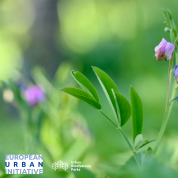The Skanssi Biodiversity Park offers a new way to tackle habitat loss, protect rare species and promote biodiversity in urban areas. Over the next three years, Skanssi will experiment with a range of different biodiversity-enhancing management methods.
Text continues after video
The park is the first of its kind in Europe. It differs from traditional nature reserves in that it not only protects but also actively enhances biodiversity. The creation of the park will further enhance the natural values of the area and will also create an attractive recreational area for city dwellers to learn about nature. As some of the ways of enhancing nature are experimental, the biodiversity park will advance the development of methods for biodiversity conservation throughout Finland.
Turku aims to be one of the leading nature cities by 2030. Nature cover is a serious risk that requires action from all of us to stop.
Involving residents
The Skanssi Biodiversity Park is an open recreational and outdoor area for everyone, offering opportunities for learning about nature.
In the residential areas of Halinen and Jyrkkälä, methods are being tested to enhance biodiversity. Small-scale pilot projects to enrich nature are being planned and implemented together with residents and communities.
New ways of engaging residents and collecting opinions are being developed by listening to the community.
The park's activities and different ways of managing nature are developed and tested together with residents, students and experts. The residents' nature group is open to anyone interested in the subject. Common nature management activities include building a reef fence, weeding festivals, moss raking, invasive species removal, planting and seeding.
Join the residents' group using the Valonia form: valonia.fi/nature-group.
One of the few sandy ridges in the Turku region
The Skanssinmäki ridge, one of the few sandy ridges in the Turku region, was used as a gravel extraction site until the 1970s. Since then, the area has been largely overgrown, but is now being developed as part of a biodiversity park. In many parts of the Skanssi Ridge, the even-aged forest is dominated by stunted pine trees. The aim is to diversify the age structure and species diversity of the stand. During the winter of 2025, small-scale felling will be carried out in the forests of the area. The small openings will increase the amount of decayed wood in the Skanssi forest area and the increase in light will lead to a greater species diversity and an increase in the number of deciduous trees. Some of the trees will also be felled, gradually dying back and providing habitat for decaying species.
Cutting down trees is a prerequisite for restoring the area as a birch habitat. Escarpment habitats, such as the southern slopes of sand spits and gravel pits, are important but threatened habitats. Restoring light to the hillside will support the growth of endangered heathland plants such as beak moss and lady's finger, which will also attract warmth-loving butterflies and other rare insects.
Developing the whole Skanssi region
The Skanssi Biodiversity Park is located in the Skanssi residential area, which has been under development since 2016. Housing for a total of 6,000–7,000 residents is planned near the park. The area covers approximately 120 hectares and is expected to be fully completed in the 2030s.
Skanssi will get more low-rise and high-rise apartments, including a local sports area with a sand pit, a pump track, exercise equipment and lots of new jogging trails. The completed central park will be ready in summer 2027, when the roadworks will also be finished.
From the outset, the neighbourhood has been designed not only to be attractive to families with children, but also to be very close to nature. Just under half of Skanssi will remain green.
The Skanssi forest to the east of the Vallikatu area will also be completely protected from development and will serve as a recreational area for residents and visitors. Increasing human impact and consumption of forest habitat will be limited to the existing network of trails.
Schedule
-
Summer 2024
BioBlitz events
-
Summer 2025
Experiments in Halinen and Jyrkkälä
-
ActiveAutumn 2025
Market dialogues for businesses on biodiversity
-
Spring 2026
Nature work with communities in Skanssi
-
Summer 2026
The Vaso pilot for Runosmäki will be completed
-
Autumn 2026
Pilots for the Halinen and Jyrkkälä residential areas
-
Summer 2027
Inauguration of the Skanssi Biodiversity Park
The Skanssi Biodiversity Park is part of the Urban Biodiversity Parks project, which has received funding from the European Union's European Urban Initiative - Innovative Actions (EUI-IA) funding programme.
The City of Turku has more than 100 ongoing projects with external funding, worth an average of €60 million per year. Project funding is sought from the European Union and Finnish funding channels. The projects are used to develop Turku in a variety of ways and to create new operating models and innovations. Through external funding, Turku is also strongly involved in a number of national and international cooperation networks. The projects help to create a better Turku for all.
Related content:



